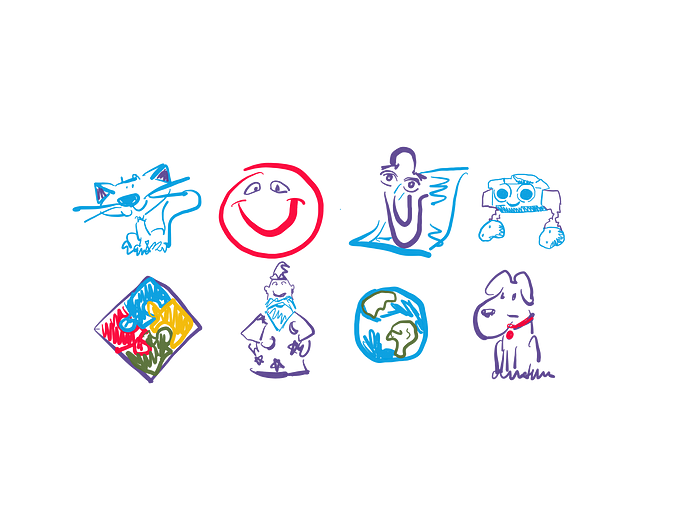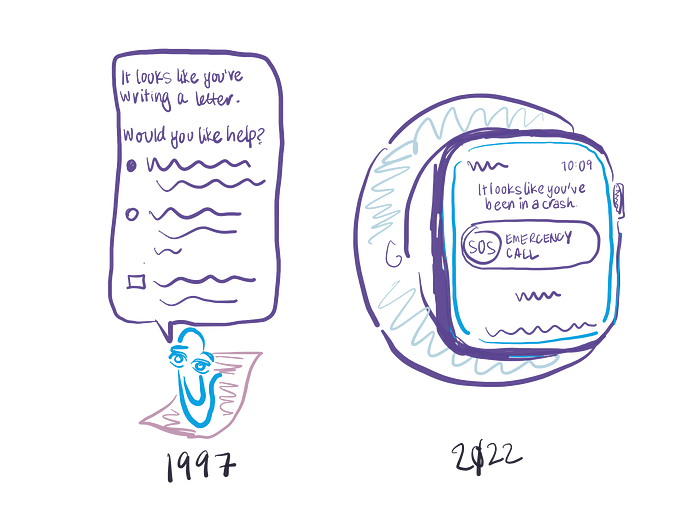

We love to hate Clippy — but what if Clippy was right?
source link: https://uxdesign.cc/we-love-to-hate-clippy-but-what-if-clippy-was-right-472883c55f2e
Go to the source link to view the article. You can view the picture content, updated content and better typesetting reading experience. If the link is broken, please click the button below to view the snapshot at that time.
We love to hate Clippy — but what if Clippy was right?
How Clippy shaped the design world.

Personalise your Clippy
We met in my primary school library. I didn’t really invite you to look over my shoulder, but I didn’t mind it either. I was a nine-year-old starting a school newspaper with my friends. We would sell a paper for $2 a pop and be rich enough to feast on sausage rolls and meat pies from the tuckshop.
You asked if I needed help, showed me some templates, and then just hung about, wiggling every now and then. I was glad for the company, being a writer can be a terrifying, lonely thing.
I fell in love with Clippy (the artist formerly known as Clippit). As I would stare at the blinking cursor and start tapping away on the keyboard, there was a sigh from my soul when Clippy recognised what I was trying to do. Yes, I am writing a letter, how did you know? Yes! I am a writer of letters! My lunchtime labours of love in the library would slowly ripen with Clippy keeping me company.
Clippy was the first computer software that recognised my intent and helped me, and I’ve been chasing that feeling ever since.
There were so many design patterns that came from Clippy, so many genius moves. Take the help out of the docs and into people’s hands when they need it. Create the first-time use. Show templates. Allow users to re-skin and customise their assistant. Throw a recognisable face on a tooltip.
Let’s take one of these: I’ll expand on the genius move of putting a face onto a computer feature. The Stanford social psychologists that informed the decisions around Clippy recognised that humans respond to computers as if it was a human, so hey, let’s play with putting a face on a software tool. Babies prioritise faces when they are focusing their eyes for the first time and this continues as we age. Some smart people at University of Sydney coined this facial pareidolia. We’ll see a face in everything; a cloud, a rock crevice, a paper clip with stoner eyes.
Society often makes fun of the person that comes up with a new theory. Aristarchus (It seems Aristarchus joined the first name club; like Lady Gaga and Cher) believed the sun was the centre of the solar system in 300BCE but was told that the maths don’t add up. Charles Darwin sat on his theory of natural selection for eight years because he knew that haters were gonna hate it. Ignaz Semmelweis was dismissed by the medical industry when he suggested the novel idea that doctors wash their hands in between handling cadavers and assisting women giving birth.
Clippy was a new theory. It was the idea that a piece of computer software could be as useful as a human coach. The late 1990s was a time when 15% or less of households had a computer, software used to come with printed manuals and during usability testing of Microsoft Office, people were too scared to move the mouse.
“What a lot of people don’t understand is, in the ’90s, the majority of people had not touched a computer,” says Karen Fries in an article by Seattle Met “They didn’t know how a menu worked.”
Clippy was designed for first-time use and would interrupt you in order to be helpful, repeatedly.
Honestly, we still haven’t nailed this human/computer interaction in 2022. I’m impressed by my interactions with Google Assistant and Siri, but still hit invisible walls in our conversations.

You could choose the avatar for your Office Assistant that transcended gender and species boundaries
Clippy was very gender-queer for 1997. You could change character, age, and species to a pup, Shakespeare, a red dot, Mother Earth, a cat, a wizard. There were elements of magic and delight that didn’t ladder up to an OKR that nevertheless got developed. It’s a playfulness that video games have cottoned onto but voice assistants long to replicate.
It’s incredibly easy and lazy to hate on Clippy, in part because it was the first pass at “let me help you” that we all had shared access to. It came with Microsoft Office; we all had the same CD. It’s in the shared vernacular in a way that’s hard to replicate in 2022, where we have niches on niches on niches that mimic our own little bubble. Shared experiences are hard to come by (unless it’s a global pandemic).
With Clippy we appreciated the help until it just lingered. In an article in Artsy, Clifford Nass, one of the Stanford psychologists, described why people started to turn on Clippy. “No matter how long users worked with Clippy, he never learned their names or preferences,” Nass wrote in The Man Who Lied to His Laptop, a 2010 book about human-computer relationships. “Indeed, Clippy made it clear he was not at all interested in getting to know them. If you think of Clippy as a person, of course he would evoke hatred and scorn.”
Kevan J. Atteberry, the designer behind Clippy cops it on the chin like a champ on his website. Microsoft chose to ride the hate wave into a self-depreciating campaign that violently celebrated Clippy’s end of life.
So here’s the thing: we may have fallen into group think and are dismissive about Clippy, but the impact and influence of Clippy is pervasive and powerful.
Just like Clippy, “AI-driven” chatbots lurk in the bottom right-hand corner of every online shop — ready to shove a discount code in your hand or automate a return. Audrey Watters expands on Clippy’s influence in educational chatbots.
Canva has been optimising the Microsoft Publisher suggestion and sensible defaults beyond what we thought was capable.
The first time use of a new software can be an act of beauty, like how Squarespace helped users design their site.

“It looks like you’re” is a piece of content design that is still being used in the most crucial of chat conversations
Last week, Apple released a feature called “Crash detection” that would detect if you were in a car accident and call emergency on your behalf. Complex, time-sensitive and life-saving stuff. You wanna know what content design pattern they borrowed from? Ol’ mate Clippy.
Every time there is a marathon design-thinking session, where the tables are littered with post-its and the smell of sharpies and body odour are in the air, someone will inevitably say “The solution should be like Clippy, but better”.
We’re still chasing the dream of being helpful, squeezing the most out of the software, and being so ‘seamless’ that no one notices we helped at all, and we should appreciate that Clippy was trying to do the same.
The best experiences are the ones where the user feels understood and is gently given a platonic pat on the bum in the right direction.
It doesn’t matter if your app is B2B, B2C or B2B2C. You are designing for humans.
The most universal need as a human is to be recognised, to be seen, and to be helped along in our path. That’s all we want and when a software process manages to do that in some small way, it’s magical.
Clippy, thank you for helping a nine-year-old write her first story in her school library. Thank you for living the dream, man even if you had early onset Alzheimers, we know your intentions were good. At the end of it all, you evoked a range of emotions from the tapestry of humanity when there’s so much software that emits nothing.
As Neil Young wrote in a song:
Rock and roll is here to stay
It’s better to burn out than to fade away.
Long live Clippy’s presence and may it/they/he/she continue to inspire you.
References:
Recommend
About Joyk
Aggregate valuable and interesting links.
Joyk means Joy of geeK